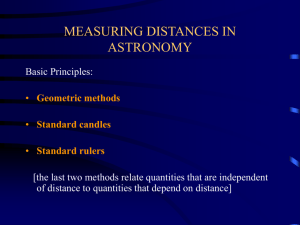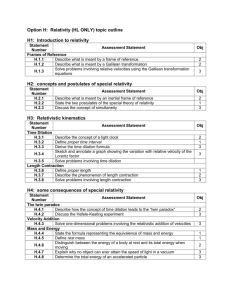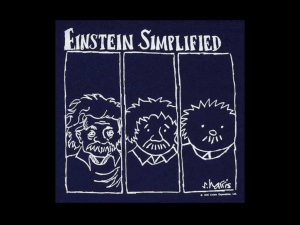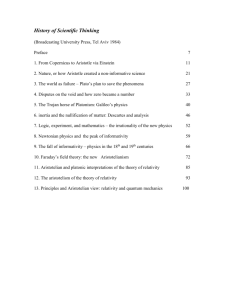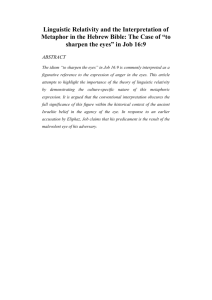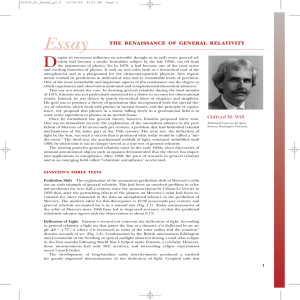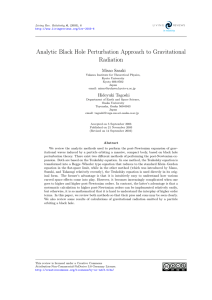Which of the following statements is TRUE
advertisement
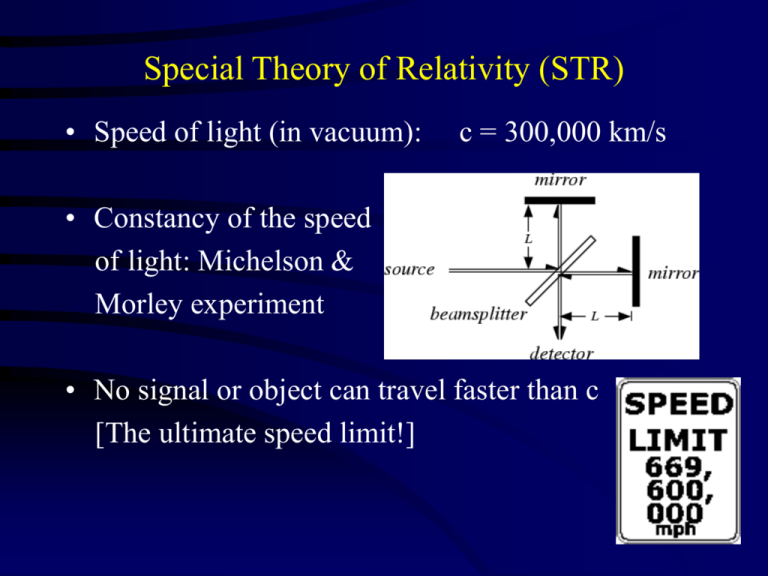
Special Theory of Relativity (STR) • Speed of light (in vacuum): c = 300,000 km/s • Constancy of the speed of light: Michelson & Morley experiment • No signal or object can travel faster than c [The ultimate speed limit!] Special Theory of Relativity (STR) Basic Principles • The speed of light is the same to all observers • The laws of physics are the same to all observers Observable Consequences • Simultaneity is a relative concept • Length contraction: moving rulers appear to be short • Time dilation: moving clocks appear to run slow • The apparent mass (inertia) of an object increases as its increases (impossible to accelerate it up to c) • Equivalence of mass and energy: E = mc2 speed Special relativistic effects are important when the SPEED of an object is CLOSE TO THE SPEED OF LIGHT: v ≈ c Simultaneity and time are relative, not absolute A B Marion Jones sees A and B flash simultaneously A B Marion Jones sees A flash before B Measuring the length of a moving object: Length Contraction The apparent (i.e., measured) length of a moving object is shorter than the “true” length (measured when the object is at rest) Measuring time on a moving clock: Time Dilation Stationary Clock Moving Clock A moving clock runs slower than its counterpart at rest Special Relativity Formulae Length contraction • L = L0 [ 1 – (v/c)2 ]1/2 Time dilation • T = T0 / [ 1 – (v/c)2 ]1/2 The factor • = 1 / [ 1 – (v/c)2 ]1/2 • Examples: If v = 0, = 1 v = 240,000 km/s, = 1.6 A Thought Experiment: Length Contraction and an Apparent Paradox The Garage Attendant’s Perspective Stationary Car Moving Car Moving Car A Thought Experiment: Length Contraction and an Apparent Paradox The Driver’s Perspective Stationary Garage Moving Garage Moving Garage Moving Garage Solution: The driver and garage attendant do not agree on the question of whether the two doors were closed simultaneously A Real Laboratory Experiment: Direct Verification of Time Dilation and Length Contraction as Predicted by the Special Theory of Relativity Suitably placed Geiger counter Beam of fast-moving Uranium atoms Nuclear fission of Uranium atoms The scientist in the laboratory witnesses time dilation, while the Uranium atoms “witness” length contraction General Theory of Relativity (GTR) Principle of Equivalence • All objects experience the same motion in a given gravitational field, irrespective of their mass [Galileo's experiment at the leaning tower of Pisa] • Gravitational field <===> Accelerated reference frame • Gravity can be thought of as a distortion of space-time Observable Consequences of GTR • Perihelion precession of Mercury • Light bending: Solar eclipse experiment • Gravitational lensing: Multiple images, image distortion • Gravitational Redshift [Extreme case: light is “trapped” in a black hole] General relativistic effects are important in a STRONG GRAVITATIONAL FIELD i>clicker Quiz #11 Which of the following statements is TRUE: A. Einstein first postulated the constancy of the speed of light in formulating his general theory of relativity B. The equivalence of mass and energy is best expressed through the formula: E = mc2 C. Gravitational redshift is a feature of the special theory of relativity D. The fact that gravity is equivalent to an accelerated frame of reference is the basis of the special theory of relativity Quasars, Active Galactic Nuclei (AGN), and Black Holes What is an “active galaxy” or “quasar”? How is it different from a “normal” galaxy? • • • • • 1. Much, much more luminous 2. Brightness varies rapidly with time [Implication: light emitting region must be small!] 3. Broad emission lines 4. Non-stellar radiation 5. Jets / radio lobes Rapid Variations in Brightness • Intrinsic variations in the luminosity of the quasar get smeared out from our perspective by the difference in light travel time across the emitting region Astronomer 1 light week • Thus, the rapid variations seen in the luminosity of quasars imply that the size of the light emitting region must be relatively small Broad Emission Lines / Non-stellar radiation Jet and Radio Lobe in the Active Galaxy M87 Concept of a Black Hole • Escape velocity from the Earth’s surface: 11 km/s • Definition of escape velocity: (vesc)2 = 2 G M / r • When the escape velocity for an object reaches the speed of light, not even light can escape from it. Such an object is called a BLACK HOLE! • Definition of event horizon or Schwarzschild radius: RBH = 2 G M / c2 The size of the region around a black hole’s within which its gravitational influence is strong enough to trap light! • Matter loses its identity when it falls into the event horizon of a black hole. The famous Princeton physicist coined a theorem: A BLACK HOLE HAS NO HAIR!!!! Models of Active Galaxies Black holes: Natural explanation of AGNs and quasars • Definition of event horizon or Schwarzschild radius: RBH = 2 G M / c2 [Characteristic size of region over which radiation is emitted is comparable to Schwarzschild radius of the central black hole] • • • Rapid motion of material swirling into black hole Large Doppler shifts Efficient energy production Models of Active Galaxies Standard model: • Accretion disk around black hole • Dense, dusty gas torus outside accretion disk • Gas clouds heated by radiation from accretion disk • Appearance depends on viewing geometry (face-on vs. pole-on) Synchrotron radiation (mostly at radio wavelengths) • Charged particles spiral around magnetic field lines Jets and radio lobes • Two oppositely-directed rapid streams of material • Jets plough into the intergalactic medium, are slowed down by friction, and produce radio lobes at the ends Hawking Radiation • Spontaneous pair production and pair annihilation near the event horizon of a BH • BH radiates like a black body: T α 1 / MBH • Evaporation of BH: 1 M BH lasts for as long as 1070 yrs! ●
